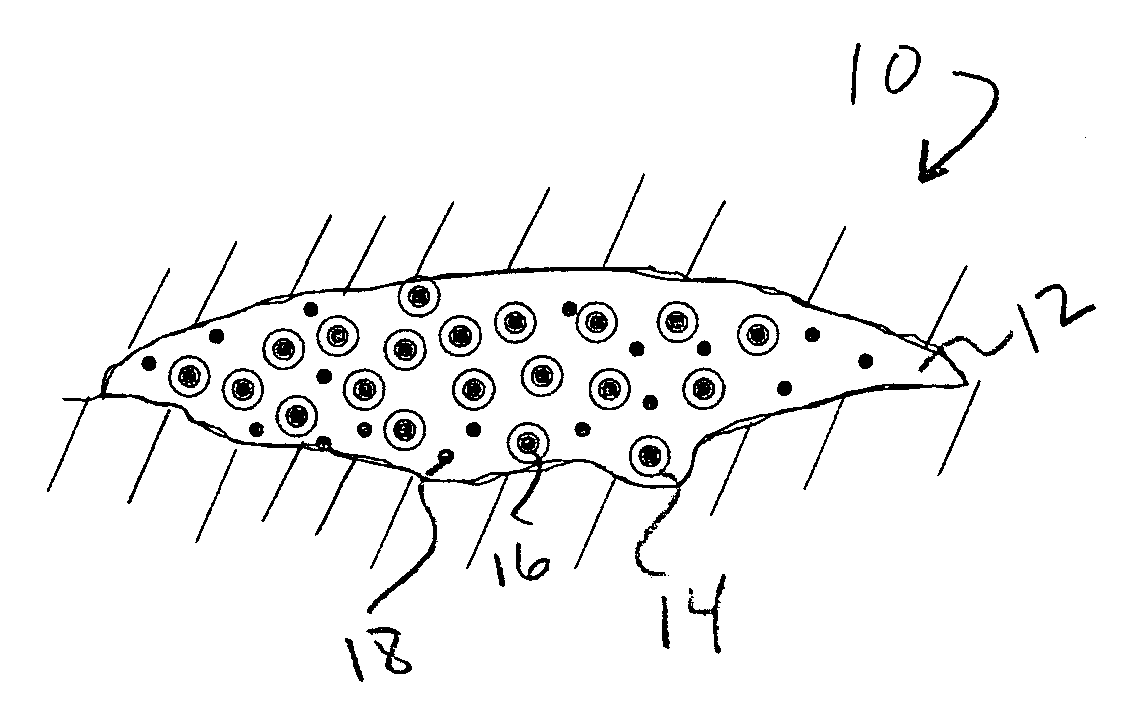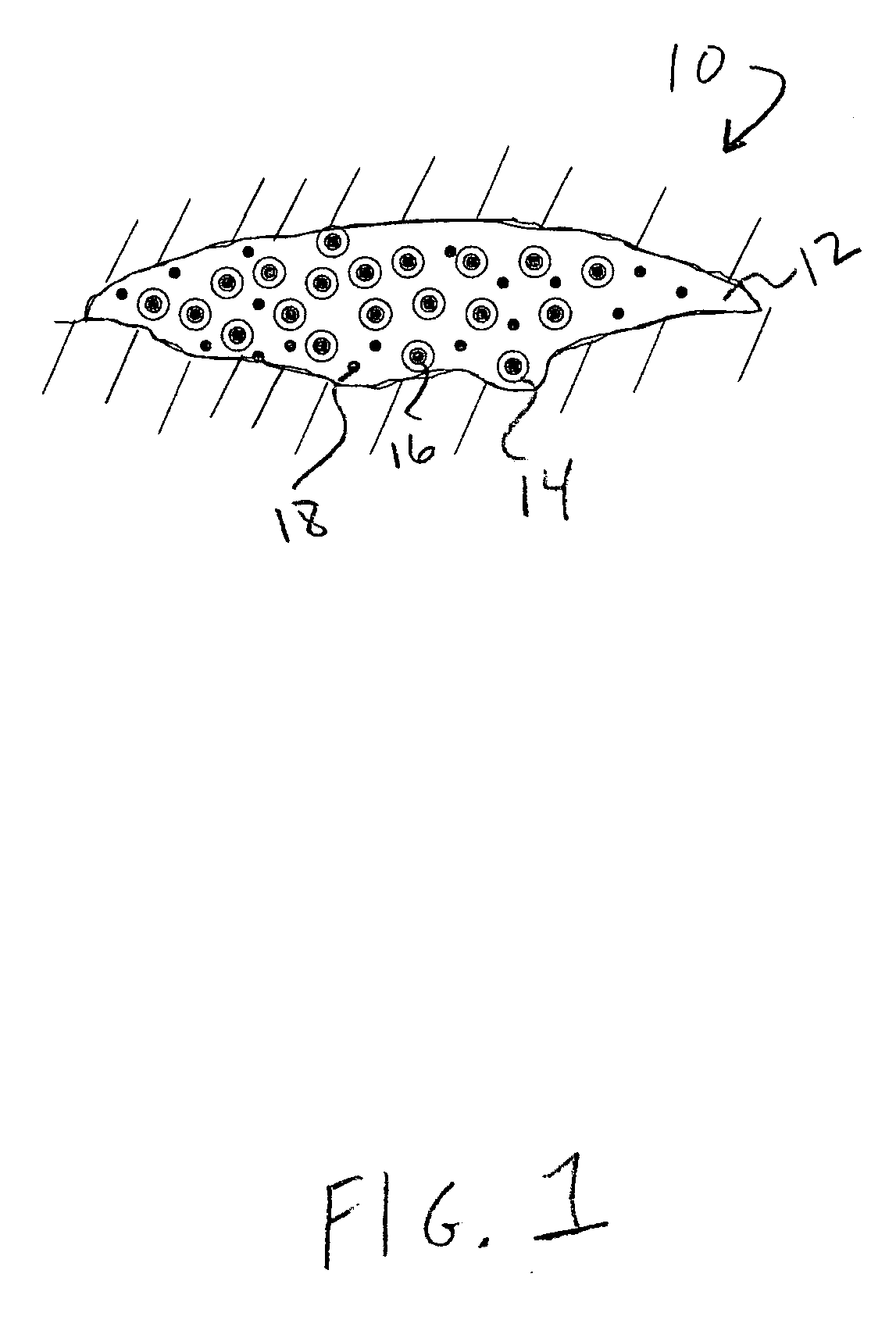Drug delivery vehicle containing vesicles in a hydrogel base
a hydrogel base and vesicles technology, applied in the field of drugs delivery, can solve the problems of difficult to achieve prolonged release of liposome-encapsulated agents in vivo, difficult to manufacture, sterilize and store liposomes, micelles are solid structures, etc., and achieve the effect of prolonging the release of encapsulated active agents and prolonging the release of encapsulated agents
- Summary
- Abstract
- Description
- Claims
- Application Information
AI Technical Summary
Benefits of technology
Problems solved by technology
Method used
Image
Examples
example 1
Passive Diffusion from Vesicles
[0062]The following vehicle will provide passive release of an active agent out of the vesicles and hydrogel matrix. Carboxy-fluorescein is soluble in both segments of the block copolymer and will slowly diffuse out of the vesicles and then be released from the hydrogel.
[0063]Vesicles are made out of the block copolymer poly(2-methyl-2-oxazoline)-b-polydimethylsiloxane-b-poly(2-methyl-2-oxazoline). Molecular weights of the segments are poly(2-methyl-2-oxazoline): 1300, and PDMS segment: 4400. The copolymer is made as described in U.S. Pat. No. 5,807,944 to Hirt et al.
[0064]A total of 50 mg of polymer was dissolved in 250 μl of ethanol (99%). The ethanolic solution was slowly added to 5 ml of bi-distilled water containing 0.2 M carboxy-fluorescein. A minimum of 4 h of stirring was allowed. Subsequently, the vesicles were extruded through 0.45 μm and 0.22 μm filters (Millex Durapore-PVDF, Millipore) 6 times. This procedure ensures formation of unilamella...
example 2
Release from pH Responsive Vesicles
[0068]The following vehicle will provide release of an active agent out of the vesicles in response to a change in pH. The lidocaine HCl will be released slowly with increasing pH, with an increased rate after pH 5.
[0069]The vesicles are made from the block copolymer poly(2-vinylpyridine-b-ethylene oxide) (NP2VP:29,NPEO: 15) This polymer can be made as described in Foerster et al., Langmuir, 2006, 22, 5843-5847.
[0070]The hydrogel matrix is the same as Example 1.
[0071]The vesicles are loaded with lidocaine HCl, via a phase transfer method from chloroform to water, and cleaned over a Sepharose column. The resulting vesicles formulation is mixed with the PVA-acrylamide macromer and Irgacure 2959.3 g of the hydrogel is crosslinked with UV and immersed in 5 ml buffer solution at pH 4. The 5 ml buffer is exchanged after 8-16 h with 5 ml buffer solution at 0.5 pH units higher and left for another 8-16 h. This is repeated until pH 6.5 is reached. About 80%...
example 3
Release by Hydrolysis
[0072]The following vehicle provides release of an active agent out of the vesicles as a result of hydrolysis of the vesicles.
[0073]The vesicles are made from the block copolymer polyethyleneglycol-b-polycaprolacton-b-polyethylenglycol (Mn: 1000-5000-1000) as taught in B. Jeong et al, Biomacromolecules 2005, 6, 885-890.
[0074]The hydrogel matrix is the same as in Example 1.
[0075]The vesicles are loaded with lidocaine HCl at pH 6.5 and cleaned over a Sepharose column as taught in Example 1. The resulting vesicles formulation is mixed with the PVA-acrylamide macromer and Irgacure 2959.5 times 3 g of the hydrogel is crosslinked with UV and immersed in 5 ml buffer solutions at different pH. The five solutions have pHs of 3, 4, 5, 6 and 7. The vesicles are left for 24 hours in the solution before it is exchanged for fresh buffer solution. The used buffer solution is analyzed by UV at 263 nm for the lidocaine concentration as taught in Example 2.
PUM
| Property | Measurement | Unit |
|---|---|---|
| particle radius | aaaaa | aaaaa |
| particle radius | aaaaa | aaaaa |
| sizes | aaaaa | aaaaa |
Abstract
Description
Claims
Application Information
 Login to View More
Login to View More - R&D
- Intellectual Property
- Life Sciences
- Materials
- Tech Scout
- Unparalleled Data Quality
- Higher Quality Content
- 60% Fewer Hallucinations
Browse by: Latest US Patents, China's latest patents, Technical Efficacy Thesaurus, Application Domain, Technology Topic, Popular Technical Reports.
© 2025 PatSnap. All rights reserved.Legal|Privacy policy|Modern Slavery Act Transparency Statement|Sitemap|About US| Contact US: help@patsnap.com


